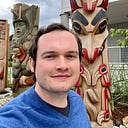Comments on Ḵaax̱gal.aat Yagiyee (Elizabeth Peratrovich Day) 2023
The following is a slightly-modified version of a speech I gave yesterday, February 16th, 2023, as part of celebrations honoring Ḵaax̱gal.aat Yagiyee, Elizabeth Peratrovich Day. The speech was given at Ketchikan High School in Kichx̱áan, the town commonly known as Ketchikan, which is located on the lands of the Taantʼa and Sanyaa ḵwáan (Tongass and Cape Fox people) in Lingít Aaní (Tlingit Country).
Yakʼéi x̱áanaa, ldakát yeewháan. Ḵúnáx̱ likoodzi áyá, yee x̱wsateení yá x̱áanaa. Sigóowu Ḵaax̱gal.aat Yagiyee! Good evening everyone. It is really wonderful to see all of you this evening. Happy Ḵaax̱gal.aat Elizabeth Peratrovich Day!
My name is Peter Stanton, and I am a history teacher here at Ketchikan High School. I was honored to be asked to speak to you briefly tonight about Ḵaax̱gal.aat, Elizabeth Peratrovich, and her place in haa shagóon, our history here on this land. I use the Lingít word shagóon very purposefully, because it isn’t just equivalent to the word “history” in English. Shagóon has a deeper meaning in Lingít culture, and the word can be translated as heritage, origins, where we come from. It has even been translated as “everything we have ever been, everything we are right now, and everything we are going to become.”
When I think about Ḵaax̱gal.aat shagóon, the history of Elizabeth Peratrovich—her heritage, and her legacy that we are still living out today—I can’t help thinking about the world that she was born into in 1911, in Séet Ká (Petersburg, Alaska). In 1911, Lingít Aaní (Tlingit Country)—and indeed, all of Alaska and all of its Indigenous nations—was going through an unprecedented time of turbulence, chaos, and transformation, the effects of which are still with our society to this very day.
In 1911, Lingít, X̱aadas (Haida), Tsmʼsyen (Tsimshian), and other nations were experiencing incredibly rapid changes in their communities. Indigenous families, houses, and clans had been devastated by epidemic diseases and continued to be disproportionately impacted by major health problems. Precious at.óow, or sacred clan property, was appropriated, stolen, and exploited by newcomers, including clan-owned resource gathering sites used for millennia for fishing, hunting, and harvesting. Indigenous people had to compete to survive within a new, forcibly-implemented economic system, in which their ownership of the land and water was ignored, and newcomers held most of the capital and economic advantages.
People left behind homes in longstanding communities like Kadúḵx̱uka (Tongass Island Village), Gàash (Cape Fox Village), Katgàawtan (Howkan), Suḵw Àan (Sukkwan), Lenḵu.àan (Klinkwan), and Maxłaxaała (Metlakatla), British Columbia, and founded or relocated to new communities like Saxman, Hydaburg, Petersburg, Ketchikan, or Metlakatla, Alaska.
A new educational system and religious belief system were forcibly implemented, but soon after white missionaries brought those systems to this land, increasing numbers of white settlers moved to segregate schools, church services, neighborhoods, and businesses, creating a Jim Crow-style “color line” in Southeast Alaska that had never existed before.
In the words of the Shoshone historian Ned Blackhawk,
In the span of one generation… immigrants became settlers, settlements became towns, and Indians became outsiders.
In Southeast Alaska, that generation was the generation of Elizabeth Peratrovich's parents, aunts, and uncles. That was the Southeast Alaska that Ḵaax̱gal.aat was born into and lived in.
However, when we think about Ḵaax̱gal.aat shagóon, we also need to think about haa latseen, our strength as human beings. Ḵaax̱gal.aat, her generation, and Indigenous communities throughout Alaska were incredibly strong, and that strength is with us today. They survived, endured, adapted, and thrived through the tragedy, chaos, and change that was brought to this land. Indigenous Alaskans found where they could take advantage of and benefit from the legal, economic, political, and social systems that were imposed upon them. Many young people learned as much as they could from the American educational system, and used that knowledge to fight for their rights, their culture, and their lands.
Ḵaax̱gal.aat is a shining, ever-inspiring example of that strength, as shown in her courageous leadership within the Alaska Native Sisterhood, her incredible political advocacy and ability to challenge prejudice, her famous and powerful oratory, her success as a mother, and so many other roles and victories. She is the most famous fighter for social justice of her generation, and deservedly so, but she was not the only fighter, before or since. Let’s remember today all of the struggles for justice that so many people on this land have been, are, and will be fighting in — past, present, and future.
Aatlein gunalchéesh ax̱ xʼeit yeesa.aax̱í. Sigóowu Ḵaax̱gal.aat Yagiyee! Thank you very much for listening to me. Happy Elizabeth Peratrovich Day!
Please feel free to share your thoughts by leaving a comment below.
